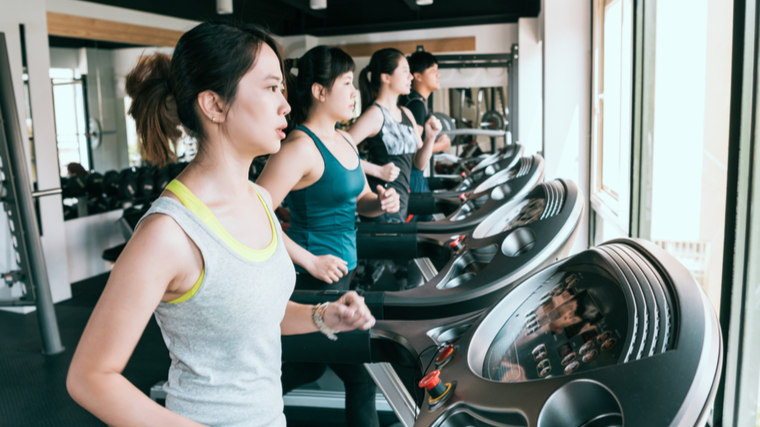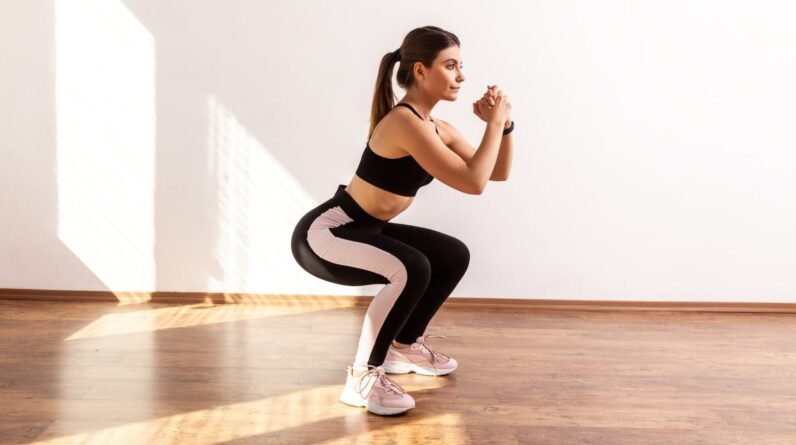
Your body naturally knows how to run, right? You ran around as a kid. You can (hopefully) run when you’re in danger. While lifting weights will always be near and dear to many people, running is a universal language. Some people run for sport, for heart health, or just for fun.

Like any skill, however, a little work can make the experience (and the results) even better. Do you want to be more competitive with yourself or others? Have you been stuck at a pace and wondering how to improve your time? Maybe it’s time to check-in and make sure you can keep up a respectable speed.
The 8-minute mile is a high-performance standard. Sustaining that pace for a marathon would complete the 26.2-mile feat in just under three and a half hours, which puts you in the top 25% to 30% of runners. For non-competitive context, the majority of military and law enforcement organizations require fitness tests which include a one and a half or two-mile run. An 8-minute mile pace would score you squarely in the middle of the pack.
No matter your reason, it’s a significant goal to aim for. Here’s a training plan to help you get there.
Weekly Plan to Get an 8-Minute Mile
It takes a detailed program to start running more efficiently and improve your running time. Here’s a plan to start shaving time off your run and keep your body balanced and healthy.
Monday
Even one day of focused weight training can build strength and functional muscle when the total training volume is sufficient. (1) A full-body workout can help runners build their legs, upper body, and core — all essential parts to being a strong runner.

“There is usually an improvement in time when a period of training is devoted to strength training,” says Yusuf Jeffers, a coach with Mile High Run Club. “Compound lifts like barbell back squats and unilateral work like lunges are good for developing muscles in the legs. Not just the quads, but also hamstrings and glutes. Muscles don’t work in isolation.”
“Core strength workouts are also of great utility. The trick is to integrate improvements in leg strength and have it expressed as power. Core strength helps with maintaining posture, all of which ultimately leads to faster times.”
Sample Strength Workout
Tuesday
Speed Workout
Run 400 meters for four to six sets with two minutes rest between each run.
Use a submaximal stride, meaning you work just below the anaerobic threshold and not at full capacity. Each run should be difficult but you shouldn’t be completely breathless.
Wednesday
Active Recovery
Active recovery is a hybrid between a day of serious training and complete rest. It can be a 30-minute walk, slow jog, or other light cardio activity at a comfortable pace. Also spend time working on flexibility, such as long, deep stretching or a Yin yoga class.
Thursday
Tempo Run
A tempo run is a distance run performed at a tempo, or speed, you can maintain for the entire duration. Start with two or three-miles at a consistent speed. As your running improves, work toward a quicker tempo and eventually increase up to five miles.
To hit the 8-minute mile pace, many runners will need to reach 180 steps per minute, or three steps per second. Consider that as an eventual target.
Tip: To stay on tempo and keep a steady pace, try listening to the Running Tempo Mix playlist on Spotify by Nike Women. You can also search many music streaming services for BPM-specific playlists depending on the speed and pace you need.
Friday
Active Recovery
Take another active recovery day for restorative work. Perform another 30-minutes of light cardio followed by more flexibility work.
Saturday
Endurance Run
This should be your longest run of the week to build overall endurance and push your physical and mental limits. Keep your speed between the “active recovery” speed and the “tempo” speed. You should be able to speak in sentences during this run. Start with three miles and increase your volume each week, eventually up to 20 miles.
Sunday
Rest
No training, no running, and no lifting. Take the day off, eat some nutritious food, and recover for the upcoming week.
Improve Your Form, Improve Your Speed
Achieving an 8-minute mile pace is a respectable achievement for any non-professional runner. It’s a sign that you’re starting to bridge the gap between recreational and specialized performance.
Even if you’re not a dedicated runner, allocating some training time to improve your running will boost your aerobic conditioning base, which can be beneficial for everything from high-rep sets of weight training to running the bases in your local rec-league softball game.
Like any exercise or skill, improving your technique can lead to better results and a lower risk of injury. Most people will invest time and energy learning how to deadlift properly because it’s seen as a relatively complicated exercise that requires coordination between multiple muscles.
However, many of those same people would simply take off on a run with minimal attention to factors that can have a significant effect on how the run feels and, more importantly, how your body responds to all those miles. Here are some of the most important cues to run more efficiently, which will shave down your time and reduce wear and tear on your joints.
Cue 1 — Drive Your Knees Forward

Many people focus on kicking their legs back as they move. Instead, focus on driving your knees forward on each step. This improves stride length and helps to activate the hip flexors and core, which are essential for optimal performance.
Form Tip: Incorporate standing high-knee drills and marching in place during your general warm-up to reinforce this type of knee-forward movement.
Cue 2 — Make Contact with the Balls of Your Feet

When striking the ground during a run, think light and quick. You don’t want to slam your foot into the ground. Most modern running teachers no longer teach a heel strike. Hitting your heels on the ground can be slow and lead to foot and ankle issues.
Instead, they teach runners to strike the ground with the balls of their feet. Have a friend watch you run or set up a camera to record your form. If you are striking back on your heel, take the time to move forward on your foot.
Form Tip: While you’re reviewing your form, check to see if you pronate or supinate your feet. If you’re shifting to the big toe-side of the foot (pronating) or the pinky toe-side of the foot (supinating) instead of remaining in a neutral position, you may be at risk of foot and ankle problems down the road. You can also check the wear patterns on the bottoms of your sneakers as an indicator.
Cue 3 — Run with Your Upper Body

Running doesn’t just happen by moving your legs. Your entire upper body needs to be involved if you want to perform well. As you start your run, think about leaning forward with your hips, chest, and ears in front of your ankles.
Keep your head and chest up by looking 50 to 100-feet ahead of you. Swing your arms like pendulums in sync with your legs. Keep your forearms passing by your sides, not across your body, and keep your arms bent about 90-degrees.
Form Tip: Keep your posture tall. Don’t allow yourself to bend forward at the waist. If your upper body starts to collapse, your overall running form will suffer and speed will slow down.
Cue 4 — Keep Your Core Engaged

Your core is essential for keeping your posture upright, as well as keeping your breath strong. Focus on keeping your core engaged and lifting up out of your pelvis.
Maintain tight enough abs so you don’t wobble side-to-side or over-rotate while you run. If your shoulders are tilting or turning significantly as you run, it’s an indicator that your core may be too relaxed and not fully engaged.
Form Tip: Practice breathing in tempo without losing core tension. Count your steps as you breathe in and breathe out, and work on breath consistency in your pacing. Start slow and determine your individual optimal number of steps per breath.
Running Mistakes to Avoid
Running may seem easy because, technically, anyone can do it anytime. However, to improve your time and become a better runner, you need to follow a structured routine. Running without a plan can lead to pain, injury, slow times, and wasted energy. Here are the most common issues to avoid.
Running Too Much
This isn’t so much a technique issue as it is an enthusiasm issue. When it comes to improving your running, some people think it’s better to just do “more” and somehow any issues will sort themselves out along the way. This isn’t true.

To become a better, faster, and more efficient runner, you need a balanced running program — like you would for any other fitness goal.
Avoid It: Follow a well-planned, structured running schedule (like the sample plan laid out earlier in this article). A comprehensive plan should include training time, varied distances, and cross-training days to build skills, balance training and recovery, and avoid injury.
Skipping Recovery
Trying to get better without rest and recovery can set you backwards in your training. Your body needs recovery days to allow your muscles to repair, your cardiovascular system to adapt, and your nervous system to refresh.

Trying to be “all gas, no brakes” won’t get you to your goals any faster and can potentially put you on the sidelines if you rack up an injury along the way.
Avoid it: Make sure your training schedule includes rest days and recovery methods, including flexibility training which can reduce soreness and improve your range of motion. (2)
Benefits of Running
Running has definite benefits, both physiologically and psychologically. Those benefits become more pronounced when supported by proper recovery and other forms of exercise.
Cardiovascular Health
Running is an aerobic, cardiovascular activity that forces active work on the heart and lungs. This work strengthens the heart and lungs and can lead to a lower resting heart rate and higher blood oxygenation. In all, this leads to better cardiovascular health and a reduced risk of cardiovascular disease. (3)
Psychological Health
A “runner’s high” is often considered to be a post-run endorphin rush, where your brain releases feel-good chemicals in response to the almost-meditative blood-pumping exercise you just completed. There’s actually an abundance of science that connects running with improved mental health. Some research even suggests that running consistently can be as beneficial as pharmaceutical intervention. (4)

Additional studies have linked a regular running routine with improved sleep, citing that some people have a significant deep sleep improvement and a reduction in insomnia with as little as two short runs per week.
Note: Avoid any interference with your current doctors’ orders. If you are on prescription medication when starting or improving your running routine, let your doctor know and monitor your results.
Fat Loss
Cardiovascular exercise is a reliable method of fat loss. Many times, a simple walk can be an effective starting point. However, running has been shown to contribute more significantly towards fat loss and improved body composition than walking. (5)
A running program not only burns calories during the run, it has also been shown to suppress one’s appetite, making it easier to stick to the type of calorie-restricted diet necessary for fat loss.
FAQs
Why do my feet hurt after running?
It may be due to running too much and/or too quickly for your foot and ankle structures to adapt, or it may be as simple as running on worn-out shoes that offer no protection from repeated impact. Typically, running shoes should be replaced after you’ve put them through 400 to 500 miles of work. Even well-built shoes begin to breakdown at that point and they no longer offer the same level of cushioning and support as intended.
It is really important to pay attention to your feet, especially foot pain. Foot pain can lead to a very painful condition, called plantar fasciitis, which can affect foot function for years to come. Have a professional check your form while you run and help you with any stride corrections. Get a pair of shoes specifically made for running. Many specialized shoe stores can analyze your gait and help you find the right shoe.
What is a side stitch and why do I get them?
There are several possible factors that can cause side stitches including the timing of your previous meal, your breathing pattern, and the tightness of the ligaments around the diaphragm.
In general, stay hydrated before, during, and after a run; work on developing a breathing pattern in sync with your strides while you run; eat a light meal two to three hours before your run; and if you have pain during a run, stop and massage the area until the pain subsides instead of trying to run through the discomfort.
Ready to Run?
Are you inspired? Good. Lace up and get going. Just remember that overdoing it is not going to set you ahead. If you want a goal to really get yourself in gear, find a local 5K and sign up. Then mark it on your calendar, follow the plan, refine your technique, and pick up your pace to start shaving your time down.
References
- Ralston, G.W., Kilgore, L., Wyatt, F.B. et al. Weekly Training Frequency Effects on Strength Gain: A Meta-Analysis. Sports Med – Open 4, 36 (2018). https://doi.org/10.1186/s40798-018-0149-9
- Sands, William & Mcneal, Jeni & Murray, Steven & Ramsey, Michael & Sato, Kimitake & Mizuguchi, Satoshi & Stone, Michael. (2013). Stretching and Its Effects on Recovery: A Review. STRENGTH AND CONDITIONING JOURNAL. 35. 30-36. 10.1519/SSC.0000000000000004.
- Lee, D. C., Pate, R. R., Lavie, C. J., Sui, X., Church, T. S., & Blair, S. N. (2014). Leisure-time running reduces all-cause and cardiovascular mortality risk. Journal of the American College of Cardiology, 64(5), 472–481. https://doi.org/10.1016/j.jacc.2014.04.058
- Oswald, F., Campbell, J., Williamson, C., Richards, J., & Kelly, P. (2020). A Scoping Review of the Relationship between Running and Mental Health. International journal of environmental research and public health, 17(21), 8059. https://doi.org/10.3390/ijerph17218059
- Williams P. T. (2013). Greater weight loss from running than walking during a 6.2-yr prospective follow-up. Medicine and science in sports and exercise, 45(4), 706–713. https://doi.org/10.1249/MSS.0b013e31827b0d0a
Special thanks to Yusuf Jeffers at Mile High Run Club. If you’re entering your first (or next) marathon, consider their specialized marathon training program.
Featured Image: PeopleImages.com – Yuri A / Shutterstock







